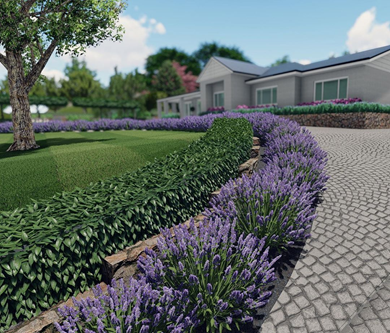A lawn is often the focal point of most gardens. When well cared for, lush green grass can add colour and vibrance to your outdoor space!
However, many factors could cause your lawn to look less than its best. The summer heat can be especially damaging to our lovely lawns and lead to a variety of problems.
In this article, we will identify some of those problems. Then, with the advice of our Sydney landscape design experts, we will help you not only correct these issues but prevent them from happening in the first place!
The Reasons Why Your Lawn Dies In Summer In Sydney

Over Watering
When living in a country with a dry, hot climate, many conclude that their lawn requires a large amount of water to survive. But, on the contrary, over-watering is one of the most common causes of lawn deterioration! Too much water can have a negative effect on your lawn, causing it to go pale and brown and creating an environment where weeds and fungus can thrive. Over-watering could even kill your lawn completely!
To ensure that your lawn stays healthy and green, water it just twice a week, making sure to soak every part of it.
Dry Spots
Hot weather can still damage your lawn, resulting in unattractive dry patches. There are a few possible causes of these bald spots, but the most common is a combination of heat exposure, lack of hydration, and foot traffic.
When an area of your lawn is thinned out by regular foot traffic or lack of water, it can become susceptible to the hot sun. This heat can cause dry, bald patches that cannot absorb nutrients from the soil or retain moisture well.
But don’t worry, this issue is simple to remedy! The easiest way to fix dry patches is to dig up the damaged area of the lawn and replace it with fresh, nutrient-rich soil so that the grass can grow again.
Another way to repair a balding grass spot is to aerate it well using a garden fork before applying a suitable wetting agent. This solution will assist the soil in absorbing water. You can also add a little bit of fertiliser to stimulate new grass growth.
Of course, the best method is to prevent dry spots from occurring in the first place! You can achieve this by watering your lawn correctly, using the correct mowing height on your lawnmower, and choosing a drought-resistant variety of grass.
Fungus
Lawn fungus can cause a multitude of issues, including unsightly dry spots, rings, and uneven patches. If left untreated, a fungal invasion can begin to attack your grass, draining it of essential nutrients and water.
Usually, a fungicide can help to resolve this problem quickly. However, if that doesn’t work, an alternative method is to remove the infected areas of the lawn and replace them with fresh soil.
The best treatment method, though, is always prevention! Implementing proper lawn care practices can help to stop fungus from growing and spreading.
Such practices include properly watering, regular mowing with sharp blades, cleaning up leaves or other debris that fall on your grass, and ensuring your lawn has adequate drainage.

Lack of Sunlight
Another factor that can lead to your lawn not looking its best is a lack of sunlight.
Your Home website gives some excellent insight on this topic when it says:
“The location of vegetation can influence choices about building orientation: a tree may shade part of a site and limit solar access but be an essential part of retaining soil, providing habitat and creating shelter. When choosing a site, take account of existing vegetation for windbreaks, shading and views, and remember that trees and vegetation can form part of the view, not just block other views."
So when deciding on where to place vegetation and trees, it is vital to take into account not just how the plant itself will be affected but also how it will influence other areas of your garden, including your lawn! Our Sydney landscaping services can assist you in designing a garden where everything is positioned in its prime location, resulting in a beautiful garden that can thrive all year round.
Pests
Insects can bring many positive effects to your garden, such as pollinating plants and helping them to grow. However, some bugs can become annoying pests that wreak havoc on your garden, including your lawn! This issue is especially a common problem in Sydney’s dry and hot climate.
Some of the most common bugs that can cause lawn issues include Grubs, Chinch bugs, Webworms and Cutworms.
If you notice any bite marks, brown spots, dying or dead areas of grass, you may be dealing with an insect invasion!
Sadly, it can be difficult to notice these pests before it’s too late. But don’t panic! You can quickly take care of these pesky bugs by spraying the affected areas of your lawn with soapy water. If this solution is not strong enough, using a more potent substance, such as an insecticide, can help rid your yard of the infestation.
While it can be difficult to prevent these pests from appearing in your garden, you can act to protect your lawn by mowing it regularly, watering it properly, and checking it frequently for the signs of a pest invasion.

Professional Landscaping in Syndey
Here at Dapple Designs, we are experts in all things landscaping, including designing and caring for lawns! So, if you are looking for expert landscaping in Sydney, we are the perfect choice.
We offer professional advice and garden landscaping services across the entire Sydney area.
Our friendly, knowledgeable staff is ready and willing to assist you! Whether you are interested in creating your dream outdoor space or looking for advice on your existing property, contact us to see how we can help you achieve your ideal garden.
Get in touch using the details below to receive your FREE consultation!
